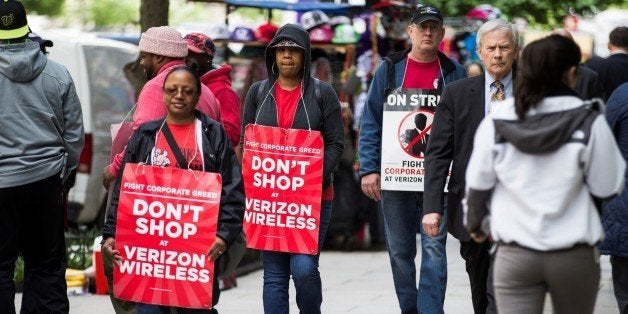
The story for workers in the United States has improved somewhat over the last year. The economy has created almost 2.5 million jobs, bringing the unemployment rate down by 0.4 percentage points. Perhaps more importantly, the percentage of the population that is employed also increased by 0.4 percentage points, meaning that unemployment is falling because people are finding jobs, not dropping out of the labor force.
Still, the employment rate for prime age workers (ages 25-54) is still down by 2.5 percentage points from its pre-recession peak, and almost 4.0 percentage points from its 2000 peaks. This translates into a drop in employment of more than 2.0 million compared to 2007 employment rates and more than 3.5 million compared to 2000 employment rates.
On the plus side, real wages are growing again. The average real hourly wage for non-supervisory workers rose by more than 2.0 percent over the last year. This is the second consecutive increase of this size, following seven years of virtual stagnation in wages for most workers.
Much of this increase reflects a one-time gain due to the fall in energy prices. Also, some of it reflects a shift from benefits to wages as employers cut back what they are pay for health care insurance. Still real wages are on an upward path at the moment, which is likely to continue if the Fed doesn't start jacking up interest rates to slow the economy.
In other positive developments for workers, more state and local governments are raising their minimum wages. The big actors in the last year are California and New York, both of which set a target of a $15.00 minimum wage for 2022. This may press the envelope in terms of how high the minimum wage can go without having a substantial impact on employment, but both laws allow for pauses if the increases appear to be increasing unemployment among low-paid workers.
Also, the Labor Department finalized rules for modernizing overtime regulations. Starting next year, more than 4 million additional workers will receive overtime pay if they are required to work more than 40 hours a week.
In addition, more state and local governments are requiring businesses to give workers paid sick days and family leave. While the business lobby groups invariable predict disaster from these measures, study after study finds that employers can easily adapt to these requirements and that they rarely result in job loss. Hillary Clinton has pledged to push these measures at the national level if she becomes president.
On the down side, there is little reason to believe that the long decline in union membership is turning around. The overall unionization rate was 11.1 percent in 2015, the same as the preceding year, although the unionization rate edged down slightly to 6.6 percent in the private sector. With several states having recently banned contracts that require the workers who benefit from a union contract to pay a representation fee, unions are likely to face greater difficulty in organizing and retaining workers in the future.
This is very bad news for those hoping that ordinary workers would share in the country's prosperity. In addition to raising the wages of their members, there is a large spillover effect on the wages of other workers, as documented in a recent paper from the Economic Policy Institute. This paper estimated that the wages of non-union workers would be 5.0 percent higher today if unionization rates had not declined from their level of four decades ago.
Unions also help to close the racial gap in pay, as documented in a new paper by Cherrie Bucknor, my colleague at the Center for Economic and Policy Research. Unions also help to reduce the pay gap between men and women.
In addition to these direct benefits, unions have also played a central role in pushing for government regulations that help large numbers of non-union workers. It is unlikely that any of the minimum wage increases, or measures requiring paid sick days and family leave would have passed, if they did not enjoy the active support of unions. The same is true of the new Labor Department regulation on overtime.
Even Federal Reserve Board policy is affected by the relative strength of unions. In the fifties and sixties, the Fed was much more welling to accommodate full employment, even at the risk of somewhat higher inflation. The Fed always gets pressure to raise interest rates, to slow inflation, from the financial industry. If there is not a countervailing force pushing for full employment, the inflation hawks are likely to get their way.
In this story it is important to remember that the decline of unions did not just happen, it was the deliberate effort by right-wingers to reduce the power of progressives. Canada, a country with a very similar economy and culture, had no comparable decline in unionization rates. Almost 30 percent of its labor force is still represented by unions.
In short, we have had some good news for working people in the last year, but there are many clouds on the horizon. Workers have a long way to go before they get back their share of the pie and the path will not be easy.
